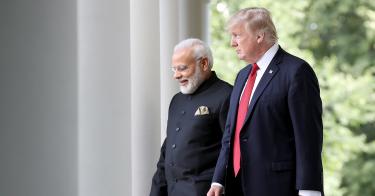President Donald Trump will arrive in India next week, his first visit to Asia’s democratic heavyweight and a lynchpin of the administration’s Indo-Pacific Strategy. It’s now clear the president won’t leave Delhi with a modest trade deal that’s been the subject of years of contentious negotiations but there will plenty of other takeaways, including some U.S. defense sales and a rousing reception in the world’s largest cricket stadium. President Trump has an avowed affinity for size and spectacle and India hosts both in spades.
In Delhi, President Trump is expected to sign at least two arms deals worth over $3.5 billion for six Apache attack helicopters ($930 million) and 24 Seahawk/Romeo anti-submarine warfare helicopters ($2.6 billion). The two sides may also discuss a $1.9 billion deal for a missile defense system that would protect the national capital, Delhi.
Indian and U.S. officials are also expected to review shared concerns about China’s Belt and Road Initiative and discuss ways to collaborate on high-standards infrastructure projects in the region, including through the new Blue Dot Network and the U.S. International Development Finance Corporation (DFC). The former is designed to “certify” infrastructure projects that meet high standards and are “open and inclusive, transparent, economically viable, financially, environmentally and socially sustainable, and compliant with international standards, laws, and regulations,” according to the U.S State Department. The DFC is a new independent agency of the U.S. government that will partner with the U.S. private sector to promote U.S. investments abroad, including in infrastructure.
President Trump and his team are also expected to raise the issue of 5G technology with India and air their concerns about the risks posed by “untrusted vendors” like Chinese telecom firm Huawei in 5G networks. While India has allowed Huawei to participate in 5G test trials, it has signaled it’s in no rush to make a final decision on building out its 5G infrastructure. Notably, Indian security agencies were raising alarms about the espionage concerns posed by Huawei over a decade ago, before most of their Western counterparts.
NEW FOUNDATIONS
While a trade deal would help ease a longstanding point of friction with Washington, the president is right to keep the visit on his schedule without one. In India, the Trump administration has a great deal to celebrate. Despite recurring irritants, India-U.S. trade volumes have reached record-breaking heights in recent years, likely topping $150 billion in 2019. More important, with a willing partner in the government of Indian Prime Minister Narendra Modi, the Trump administration has quietly but substantially strengthened the pillars of the strategic partnership while laying new foundations along the way.
Discussions of India inside the Beltway have traditionally been accompanied by lofty rhetoric and, in this case, it’s arguably justified. The transformation of the relationship has been one of the most consequential changes to the geopolitical landscape of the 21st century. By a factor of five India’s GDP and military spending are still dwarfed by China’s but the country is rapidly rising the ranks of the strategic hierarchy. It recently surpassed the UK and France to become the fifth largest economy in the world, and leapfrogged France and Russia to claim the fourth highest defense budget in the world. Before this decade is over it will surpass China with the largest population on earth.
India and the U.S. have enjoyed something of a prolonged honeymoon since President George W. Bush brushed aside decades of Cold War acrimony to forge a 10-year defense partnership and civil nuclear deal with India in 2005. Since then, the pace of progress has ebbed and flowed but the trajectory has been remarkably consistent. That’s in part due to one of the great strengths of the relationship, it has enjoyed sustained support in both capitals from governments of both main political persuasions. However, save for the euphoric courtship of the mid-2000s, arguably none have moved farther and faster than the Trump and Modi administrations over the past three years.
The list of accomplishments is long and substantial. They include: a foundational military agreement that allows for the sharing of encrypted communications and equipment; a change in U.S. export control laws that places India in a privileged category of NATO and non-NATO U.S. allies; a new “2+2” foreign and defense ministers dialogue; an exponential increase in U.S. oil exports to India; the inauguration of the first India-US tri-service military exercise and an expansion of existing military exercises; the signing of an Industrial Security Annex that will allow for greater collaboration among the two countries’ private defense industries; the inclusion of India and South Asia in a U.S. Maritime Security Initiative; a new parliamentary exchange program, and; enhanced Indian engagement with U.S. CENTCOM, including stationing an Indian officer in Bahrain and including CENTCOM in a bilateral military cooperation dialogue.
In the last two years, the Indian Navy began refueling U.S. warships at sea, and vice versa. This year the U.S. will join India’s MILAN naval exercise for the first time and the two sides will likely complete a fourth and final foundational military agreement, BECA, which facilitates the exchange of geospatial data and intelligence. India and the U.S. now enjoy working groups and cooperative mechanisms on space, cyber, counterterrorism, energy, water quality, the judiciary, nuclear cooperation, aircraft carrier operations, civil aviation, and science and technology. The two countries are training African peacekeepers together, coordinating disaster relief efforts, sharing intelligence on maritime traffic in the Indian Ocean, and collaborating to defuse regional crises.
Of course, the four million strong Indian diaspora in the U.S.—by some indicators America’s most successful expatriate community—serves as another powerful binding agent. Meanwhile, many in India’s strategic community now identify the U.S. as their country’s principal security partner and while the Indian public consistently expresses positive views toward the U.S. Indeed, they are in a minority among Indo-Pacific publics: they tell pollsters America’s influence is still on the rise and its best days are still ahead of it.
DECISIVE AND DIVISIVE
As important as these building blocks are, in recent years India and the U.S. have also come into greater alignment on some of the more decisive and divisive strategic issues of the day, including China’s Belt and Road Initiative (BRI), Pakistani-based terrorism, the Free and Open Indo-Pacific, and the Quad.
For years India stood alone in opposing the BRI, Chinese President Xi Jinping’s signature geostrategic infrastructure initiative. By 2017 it helped persuade the Trump administration to stake out a position in opposition to the BRI. Today, Delhi and Washington share the same vision for regional connectivity initiatives: high quality, transparent, and sustainable. Similarly, India welcomed the Trump administration’s decision to revoke billions of dollars in aid to rival Pakistan and target Pakistani-based terrorists with new unilateral and international sanctions.
In 2017, not long after an unprecedented standoff between Chinese and Indian border forces on the Doklam plateau, India committed to the revival of the “Quad” after a decade-long hiatus. The group, comprising the Indo-Pacific democracies of Australia, India, Japan, and the U.S., carries substantial symbolic and strategic weight and was upgraded to the ministerial level last year. Meanwhile, India and the U.S. have articulated near identical visions for a “free and open” Indo-Pacific governed by peaceful dispute settlement; freedom of navigation; respect for international law; free, fair, and reciprocal trade; transparent and responsible infrastructure, and; respect for sovereignty and independence. The Trump administration recently brought those visions into closer alignment when it stretched its definition of the Indo-Pacific to match India’s, extending the geographic boundary from the west coast of India to the east coast of Africa.
NAVIGATING DIFFERENCES
To be sure, there have been occasional hiccups in recent years, including on trade, on U.S. sanctions policy toward Iran and Russia, and on the president’s occasional, caveated offer to mediate the Kashmir dispute. However, the two sides have done an admirable job navigating these differences. Seven years ago, relations were paralyzed by the arrest of an Indian diplomat in New York. Now, the two capitals are navigating much more substantial rifts with relative ease.
The distance between the two sides on Pakistan has shrunk, even if Delhi remains skeptical of Islamabad’s recent efforts to curry favor with Washington and position itself as kingmaker in Afghan peace negotiations. Under threat of U.S. sanctions, India was able to cut oil imports from Iran last year, in part by substituting them with U.S. crude exports. Indeed, U.S. crude oil exports to India have surged from zero in 2016 to over 90 million barrels in 2019. Meanwhile, the Trump administration appears unmotivated to impose congressionally-mandated CAATSA sanctions on India for purchasing a Russian air defense system, given its indifference to NATO-ally Turkey’s purchase of the same system.
Finally, in recent months an unfamiliar dynamic has been introduced into India-U.S. relations. For the first time in recent memory, Indian domestic politics have become the subject of interest and concern in Washington. The Modi government has become embroiled in controversy over its August decision to revoke the autonomous statehood of Kashmir, accompanied by a wave of elevated security measures and restrictions in the valley.
Meanwhile, new and rumored changes to India's citizenshiplaws have the government’s critics convinced the ruling Bharatiya Janata Party (BJP) will abuse the legislation to target India's large Muslim population.The Western press has seized on these developments, and inflammatory statements by BJP officials, to warn the Indian government is drifting toward a form of neo-fascism.
The policies have drawn criticism from several Democratic presidential candidates, and Members of Congress. A letter recently addressed to Secretary of State Mike Pompeo by four senators, and two draft bills circulating Congress, articulate several congressional concerns about the security crackdown in Kashmir.
The Trump administration and most congressional Republicans have adopted a more muted approach, hopeful for an end to the restrictions in Kashmir but willing to allow India's domestic controversies to unfold in its own democratic political and judicial arenas.Some Republican Congressmen have even defended India’s policies in Kashmir on the House floor.
Left unchecked, the rift could one day threaten some of the bipartisan support India has long enjoyed in Washington. President Trump will deliver a major speech in which he is expected to praise India’s traditions as a multi-ethnic, pluralistic democracy with a history of respect for religious freedom and minorities. But for now his administration seems convinced that it’s best—for India and the U.S.—if the fight for India’s future comes from within.
LOOKING AHEAD, THE VISIT AND BEYOND
Despite the impressive level of convergence between India and the U.S. in recent years, the relationship is still dogged by critics who insist it has failed to meet expectations. However, qualitatively and quantitatively, India is now more geopolitically engaged with the U.S. than with any other country. And for the U.S., India’s importance now exceeds that of some formal U.S. treaty allies in the region. To argue the relationship is underperforming requires conjuring a set of extravagant expectations never grounded in reality.
Thanks to the hard work of senior South Asia hands in the Trump administration, and the Modi government’s continued shift away from a dogmatic attachment to “Non-Alignment,” the breadth of India-U.S. strategic convergence now exceeds what many thought possible a decade ago. While critics obsess over any headline that might portend a sliver of friction between Delhi and Washington, the two governments have been hard at work creating the lasting institutional building blocks of a 21st century strategic partnership.
While the relationship isn’t without its warts, Delhi and Washington are more aligned now than ever before. The Trump administration has already left its own lasting imprint on the partnership and will add a new chapter to the saga when the president arrives in Delhi next week.




